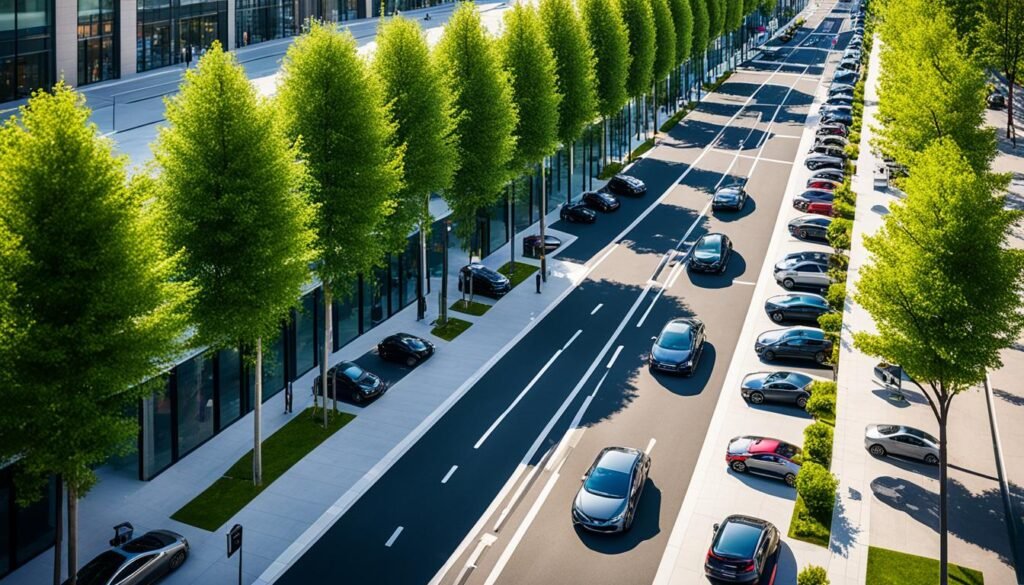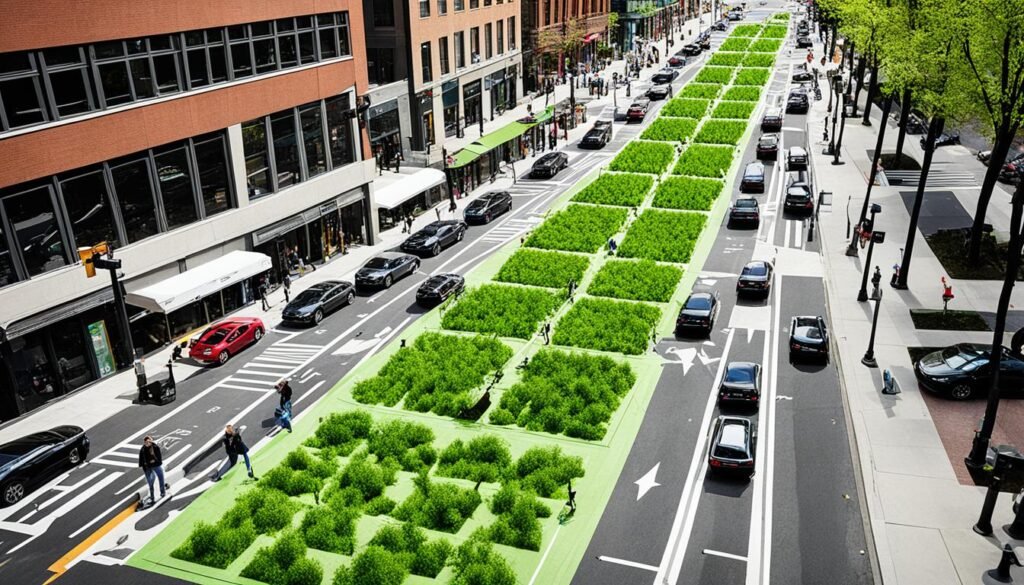Did you know that over 85% of historic urban centres in the UK face significant challenges due to limited parking? The increasing number of cars on the road coupled with the restricted availability of parking spaces has created a scarcity of parking options, causing inconvenience for residents, businesses, and visitors alike.
The charm and historical character of these urban centres make them popular destinations, attracting tourists and shoppers from all over. However, the lack of sufficient parking capacity poses a major hurdle for those who wish to explore these areas. It’s essential to find effective solutions that can address this issue without compromising the unique heritage of these cities.
Key Takeaways:
- Over 85% of historic urban centres in the UK suffer from limited parking.
- The scarcity of parking spaces causes inconvenience for residents, businesses, and visitors.
- Effective solutions are needed to alleviate the parking challenges without compromising the historical character of these areas.
- Addressing limited parking is crucial for the convenience of tourists and shoppers.
- Strategic planning and innovative approaches can maximize available parking resources in historic urban centres.
Understanding the Factors Contributing to Limited Parking
There are several factors that contribute to the limited parking situation in historic urban centres. One of the main reasons is the imbalance between parking supply and demand. Inadequate land use planning and miscalculations of space requirements during the initial stages of planning have resulted in a shortage of parking spaces. Additionally, high parking tariffs and traffic congestion caused by drivers searching for parking spots further exacerbate the problem. It is important to understand these factors in order to develop effective solutions to address the limited parking issue.
Conventional Approaches to Solving Limited Parking
Historically, traditional parking solutions for addressing limited parking in historic urban centres have included the construction of parking garages and the implementation of on-street parking. However, these conventional approaches often fall short in effectively resolving the issue.
Parking garages, for instance, can be expensive to build and maintain, making them a less sustainable option in the long run. Moreover, the limited availability of land in historic areas can make constructing these garages a challenging task. On-street parking, while providing immediate parking options, can lead to conflicts among drivers and reduce the available space for pedestrians and cyclists, impacting the overall livability of these urban centres.
Parking enforcement measures have also been employed to regulate parking in these areas. However, their success in ensuring compliance with parking regulations has been limited, as enforcement alone may not effectively address the underlying issue of limited parking supply.
“Parking garages and on-street parking solutions have proven ineffective in resolving the issue of limited parking in historic urban centres.”
It is crucial to explore alternative solutions that can effectively address the challenges of limited parking in these areas. By embracing innovative and sustainable approaches, solutions can be developed to optimize the use of the available parking capacity while preserving the historical character of the urban centres.
One such alternative is the implementation of shared parking, where multiple individuals share the same parking space at different times. This can help maximize the utilization of limited parking resources and alleviate the pressures of high demand. Additionally, the promotion of alternative transportation options, such as cycling, walking, and public transportation, can reduce the dependency on private vehicles and further mitigate the need for excessive parking.
Exploring these unconventional solutions alongside the use of technology, such as smart parking systems and parking apps, can provide real-time parking information, reservation capabilities, and improved overall parking management.
By moving away from conventional approaches and embracing innovative solutions tailored to the specific needs and constraints of historic urban centres, it is possible to overcome the challenges posed by limited parking in these areas.
Innovative Solutions for Managing Limited Parking
With advancements in technology, innovative solutions have emerged to tackle the challenge of limited parking in historic urban centres. These technology solutions offer a range of benefits, from optimizing parking capacity to promoting alternative transportation options. Let’s explore some of these groundbreaking approaches:
Smart Parking Systems
Smart parking systems incorporate cutting-edge technology to provide real-time information about parking availability. Using sensors and data analysis, these systems ensure that drivers are directed to the nearest available parking spot through smart navigation. The integration of smart parking systems not only reduces the time spent searching for parking but also alleviates congestion in urban centres, improving overall traffic flow.
Parking Apps
Parking apps have revolutionized the way people find and reserve parking spaces. These user-friendly apps allow drivers to check real-time parking availability, compare prices, and even reserve spots in advance. By utilizing this technology, drivers can plan their trips and avoid the frustration of circling around in search of a parking spot. Parking apps offer convenience and peace of mind, making parking a hassle-free experience.
Shared Parking
In response to limited parking resources, shared parking initiatives have gained popularity. This innovative concept allows multiple individuals to share the same parking space at different times. For example, a parking lot at a shopping centre can be utilized by office workers during the day and by restaurant patrons in the evening. Shared parking maximizes the use of limited parking resources and ensures efficient allocation of parking spaces.
Alternative Transportation
Encouraging alternative transportation options is another effective way to manage limited parking. By promoting cycling, walking, and public transportation, urban centres can reduce the reliance on private vehicles and ease the demand for parking. This approach not only helps alleviate congestion but also contributes to environmental sustainability by reducing emissions and improving air quality.
In summary, technology solutions such as smart parking systems and parking apps, along with shared parking and alternative transportation options, offer innovative approaches to managing limited parking in historic urban centres. By adopting these solutions, urban areas can optimize their parking capacity, enhance the overall parking experience, and create more sustainable and liveable environments.
Considering the Environmental Impacts of Parking Solutions
When implementing parking solutions, it is crucial to consider the environmental impacts. The increased use of private vehicles contributes to air pollution and greenhouse gas emissions, negatively impacting air quality and climate change. Moreover, parking infrastructure can take up valuable land space and contribute to the loss of green areas in urban centres. Noise pollution caused by traffic and parking activities also affects the livability of these areas. Therefore, it is necessary to prioritize sustainable parking solutions that minimize environmental impacts and promote a more sustainable and livable urban environment.
Impact on Air Quality and Emissions
The reliance on private vehicles for transportation in urban areas significantly contributes to air pollution and greenhouse gas emissions. The exhaust emissions from cars release harmful pollutants, including nitrogen oxides (NOx) and particulate matter (PM), which have adverse effects on air quality and human health. These pollutants not only cause respiratory problems but also contribute to the formation of smog and respiratory diseases. By reducing the number of vehicles on the road and promoting sustainable transportation alternatives, we can improve air quality and decrease emissions in urban areas.
Loss of Green Areas and Land Space
The construction of parking infrastructure often requires the use of valuable land space, leading to the loss of green areas in urban centres. Green spaces play a crucial role in maintaining ecological balance and providing recreational spaces for residents. They contribute to urban cooling, absorb carbon dioxide, and enhance biodiversity. Encouraging sustainable parking solutions that optimize the use of limited space can help preserve green areas and maintain the ecological balance of urban environments.
Noise Pollution and Urban Livability
“Noise pollution is a major concern in urban areas, affecting the quality of life for residents and visitors alike. The constant flow of traffic, honking horns, and car engines can disrupt sleep patterns and increase stress levels. It also hinders outdoor activities and reduces the tranquility of public spaces. Implementing parking solutions that minimize traffic congestion and promote alternative transportation options can contribute to reducing noise pollution and improving the overall livability of urban areas.”
In conclusion, addressing the limited parking issue in historic urban centres requires prioritizing sustainable solutions that minimize the environmental impacts. By focusing on reducing air pollution, preserving green areas, and mitigating noise pollution, we can create more environmentally sustainable and livable urban environments. It is essential for cities and communities to prioritize the long-term well-being of residents and the health of the environment when implementing parking solutions.
Conclusion
Tackling the challenge of limited parking in historic urban centres requires a combination of strategic solutions and innovative approaches. By understanding the factors contributing to limited parking and exploring alternative solutions, it is possible to optimize the use of available parking resources while preserving the historical character of these areas.
Additionally, considering the environmental impacts of parking solutions is essential for creating sustainable and livable urban environments. It is crucial to prioritize limited parking solutions that minimize environmental impacts, such as air pollution, greenhouse gas emissions, and noise pollution. This will contribute to improving the overall quality of life and urban livability in these areas.
For further information and assistance in finding parking management companies that specialize in addressing limited parking in historic urban centres, visitors can refer to the directory section on our website. Our directory provides a comprehensive list of reliable and professional parking management companies that can offer tailored solutions to meet specific needs and requirements.
Furthermore, visitors can also explore our Parking News Section for additional news and articles related to parking solutions in urban centres. Our news section regularly updates with the latest developments, best practices, and success stories within the parking industry. Stay informed and be part of the conversation on how limited parking challenges are being addressed across historic urban centres.




